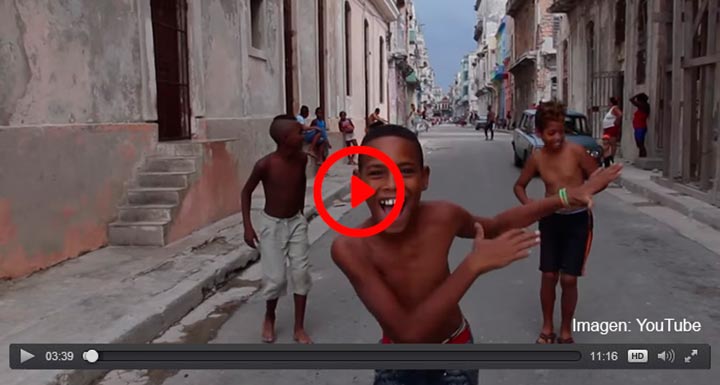
‘Happy in La Habana,’ Part Two
HAVANA — The authors of the Cuban version of the video clip “Happy,” originally performed by American singer Pharrell Williams, have returned to the stage and the featured players of a work that has been seen at least 125,000 times in YouTube.
They are French travelers Serge Muñoz and his daughter Emilie, who, with a video camera, captured the very essence of need and good cheer that defines today’s Cubans.
“We were on holiday, my two daughters and I, and we so enjoyed Havana that my younger daughter asked me to do a version of that song, which was very popular at the time,” the father tells Progreso Weekly in an exclusive conversation. The video “shows what Cuba is like. Nobody who has ever been in this country, even a short time, can doubt that this is Cuba.”
A student of cinema, Emilie confesses that she did a previous version of “Happy” in her native Cannes, with as much planning as the music video industry requires. But, she says, that experience paled when compared with the charm of the improvisation displayed by the people who walked the often dirty streets in downtown Havana and Old Havana.
The girl says that she is part of a generation in Europe that has lived with the Internet since childhood and consumes more audiovisuals online than on television. That is why, after she had the idea, she did not hesitate to tape it.
“I immediately thought of putting [the video] on the Web, because my intention was to give it as a present to all Internauts, without commercial interest,” she says.
The whole world dances

“We asked the people if they wanted to dance in front of the camera, to the beat of the music we played, and the people told us ‘yes’ or ‘no’ right away. Most of them said ‘yes’ and things worked out very easily,” Serge says.
“Some of the people knew the song, other’s didn’t, especially the children. And you have no idea how hard it is to prompt a young Cuban boy to dance!” he adds, jokingly.
The spontaneity caught by the camera might make you think that the sequence of a blind man having a good time was choreographed, but the producers deny it.
“He was an engineer who, because of another illness, lost his eyesight. We met him on the street — as we did all others — and asked him to participate. ‘Of course!’ he answered. And there he is.”
After careful editing, uploading the work generated some tense moments.
“In the first several days, I though the project wouldn’t work, because only 200 visits a day came in,” Emilie says. “But suddenly it caught fire and spread at the rate of 10,000 a day.”
“Some beautiful things have happened. For example, someone wrote to us from the United States saying that he recognized a relative that he hadn’t seen for 15 years. It was incredible!” the father says.
Father and daughter smile when they say that they found a bar in Havana where the video is shown constantly. When the manager of their hotel found out who they were, he voiced his admiration, because he was very familiar with the video.
Some viewers of YouTube have commented on the contrast between the poverty that’s evident in the neighborhoods that were videotaped and the good cheer of the residents. Some observed: “How come there are no white people in Cuba?”
The work conceived by this French family did not carry a political message or was racially cast. As the father says, “we didn’t select whites, blacks or Asians. We filmed whoever agreed to appear, and the only message we wanted to send was happiness and joie de vivre.”
Apparently, the natural joy of the original song will continue to replicate, because Emilie is already preparing her second “Cuban” video.
“In it, you see a guitarist who sings on the sidewalk in front of the Capitol building. His name is Julio César, he sings very well, plays his own tunes, and we’ve become friends,” she says, showing his image on a computer tablet.
“I’m going to feature him in a clip in the same spirit, so he can get ahead in the Internet, even if he doesn’t much understand YouTube.”

